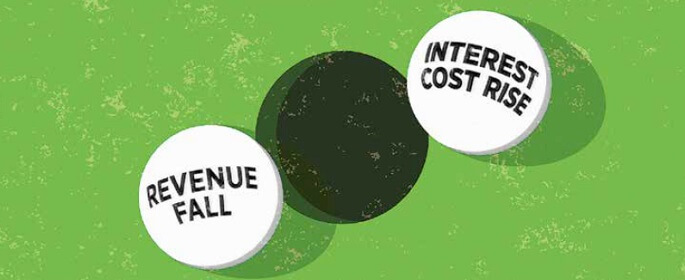
Interest rate rises can increase our costs and shrink our revenues simultaneously. An important skill in your treasurer’s toolkit is being able to recognise, calculate and comment on interest rate risk.
RATE RISE RISKS
A rise in interest rates could hurt your business in at least two important ways:
- Any floating-rate interest costs will rise.
- General demand weakens, shrinking our revenues at exactly the time we can least afford it, since greater interest costs are biting us.
Let’s look at an example:
TEE UP
TEE operates a chain of petrol stations in the UK. You have recently been appointed as treasurer and one of your first tasks is to review the financial risks that the company faces.
TEE has only floating-rate debt consisting exclusively of bank borrowings:
- Revenue and cost of sales are considered to be directly correlated to interest rate levels, with an estimated reduction of 1% for each 1% rise in interest rates.
- Bank borrowings are subject to a debt covenant specifying profit before interest and tax (PBIT)/interest of at least 4.0x.
- At the previous interest-fixing date, six-month Libor was 3% and the forecast finance charge was based on that Libor rate.
- £10m of cash and cash equivalents are invested in a mixture of money market deposits, ranging from overnight deposits to one month, with another £10m invested in instruments such as commercial paper and certificates of deposit, with an average modified duration of two months.
No interest rate hedging is currently in place.
Evaluate the extent of TEE’s exposure to a rise in interest rates
Key correctly calculated figures
|
£m |
3% Libor |
5% Libor |
Adverse change |
|
PBIT (operating profit) |
30.0 |
28.6 |
1.4 |
|
Interest cost |
5.4 |
7.8 |
2.4 |
|
PBIT ÷ interest covenant |
5.6x |
3.7x |
|
Once you have done your numerical analysis, it is just as important to comment on the significance of the results and identifying the key risks in the given scenario.
‘Evaluate’ is more than ‘calculate’
To plan any commentary, a good place to start is always with the largest monetary effects. Then move on to write about their consequences. Look again at the key calculated figures in the table above. Which adverse change is the largest?
OUTLINE EVALUATION COMMENTS EXAMPLE
- The interest cost rise is the biggest single effect, £2.4m adverse. This is nearly double the next largest effect (of £1.4m).
- We suffer a ‘double whammy’ because the effect on our operating profit is also adverse, at £1.4m. So the total adverse effect on profit before tax is: £2.4m + £1.4m = £3.8m.
- There is a potential breach of our debt covenant. The ratio falls to 3.7x, below the trigger level of 4.0x. Any breach of covenant could have serious adverse consequences for the borrower TEE.
- The potential loss on the fall in value of short-term investments is immaterial in this case, due largely to their short average maturity.
This kind of outline can, of course, be expanded further.
ALTERNATIVE ENDINGS
To finish, let’s think briefly about potential variations on our TEE petrol stations scenario. There are two important factors that might differ in another case:
- The correlation between revenues and interest rates.
- Longer-term investments or liabilities.
REVENUE CORRELATIONS
TEE’s petrol station revenues go down when interest rates go up. This is the most usual relationship between operating revenues and interest rates. In different business sectors, this relationship might be weaker, time-lagged or even reversed.
LONGER-TERM INVESTMENTS OR LIABILITIES
In TEE’s case, the value of fixed-rate investments was not sensitive to changes in interest rates, because of their short-term nature. In another case, longer-term investments and liabilities would be much more sensitive to changes in interest rates. Long-term pension liabilities, for example, are often a substantial source of interest rate risk for employers. This is a major reason for the closure of so many defined benefit pension plans.
____________________
Author: Doug Williamson
Source: The Treasurer magazine
